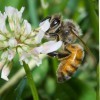Abstract
Protecting honey bees and other pollinators from pesticide impacts is important to the sustainability of agriculture. Consequently, pesticide applicators must determine if there is a clear hazard to managed or wild populations of bees. Potential exposure of bees to pesticides can vary greatly depending on the type of pesticide, formulation, application method, label restrictions, and other factors. The goal in using a pesticide is to achieve maximum benefit (success) with minimum negative impact, and these factors should always be considered in pesticide selection. This publication is written (1) to help assure the sustainability of both bees and agriculture by informing beekeepers, pesticide users, and the general public about the often complex relationship between pollinators (specifically bees) and pesticides, (2) to offer guidance for improved communication between beekeepers and pesticide users, (3) to offer pollinator risk-reducing strategies for growers and other applicators when using pesticides, and (4) to provide clarity in laws, labeling, and associated definitions. This 14-page fact sheet was written by J. D. Ellis, J. Klopchin, E. Buss, F. M. Fishel, W. H. Kern, C. Mannion, E. McAvoy, L. S. Osborne, M. Rogers, M. Sanford, H. Smith, P. Stansly, L. Stelinski, and S. Webb, and published by the UF Department of Entomology and Nematology, March 2014.
ENY-162/IN1027: Minimizing Honey Bee Exposure to Pesticides (ufl.edu)
References
Ellis, J. D., and J. Hayes. 2008. "Mosquito Control and Beekeepers." EDIS #ENY-149. http://edis.ifas.ufl.edu/in813. 3 pp. https://doi.org/10.32473/edis-in813-2008
EPA. 2012. Pollinator Risk Assessment Framework Agency White Paper. http://www.regulations.gov/#!documentDetail;D=EPA-HQ-OPP-2012-0543-0004
Fishel, F. M. 2005. "Interpreting Pesticide Label Wording." EDIS #PI-34. http://edis.ifas.ufl.edu/pi071. 7 pp. https://doi.org/10.32473/edis-pi071-2005
Fishel, F. M., and J. A. Ferrell. 2010. "Managing Pesticide Drift." EDIS #PI232. http://edis.ifas.ufl.edu/pi232. 16 pp. https://doi.org/10.32473/edis-pi232-2010
Johnson, R. M., M. D. Ellis, C. A. Mullin, and M. Frazier. 2010. "Pesticides and honey bee toxicity - USA." Apidologie, 41:312-331. DOI: 10.1051/apido/2010018. https://doi.org/10.1051/apido/2010018
Hooven, L., R. Sagili, and E. Johansen. 2013. "How to Reduce Bee Poisoning from Pesticides." Pacific Northwest Extension Publication, PNW 591, Oregon State University, University of Idaho, Washington State University, 35 pp.
Mortensen, A. N., D. R. Schmehl, and J. Ellis. 2013. "European honey bee Apis mellifera Linnaeus, and subspecies (Insecta: Hymenoptera: Apidae)." EDIS #EENY568. http://edis.ifas.ufl.edu/in1005. 6 pp.
Mullin, C. A., M. Frazier, J. L. Frazier, S. Ashcraft, R. Simonds, D. vanEngelsdorp, and J. S. Pettis. 2010. "High levels of miticides and agrochemicals in North American apiaries: implications for honey bee health." PLoS One 5: e9754. doi:10.1371/journal.pone.0009754. https://doi.org/10.1371/journal.pone.0009754
Winston, M. L. 1987. The Biology of the Honey Bee. Harvard University Press, Cambridge, Massachusetts, USA. 281 pp.

